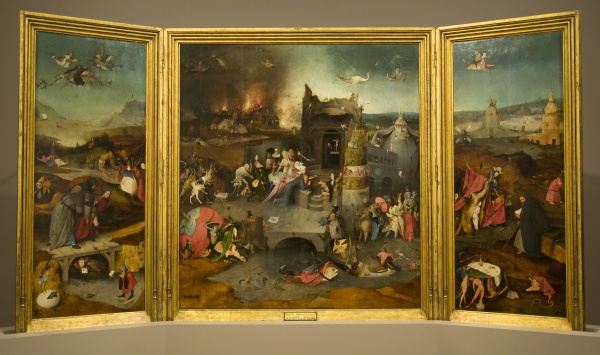Facts About Triptych of the Temptation of St. Anthony
The "Triptych of the Temptation of St. Anthony" an oil painting on wood panels by the Early Netherlandish artist Hieronymus Bosch, was created around 1501. This captivating artwork explores the mental and spiritual struggles faced by Saint Anthony the Great, a prominent figure among the Desert Fathers in Egypt during the late 3rd and early 4th centuries. The theme of St. Anthony's Temptation was quite popular in Medieval and Renaissance art. Today, this fantastical piece is housed in the Museu Nacional de Arte Antiga in Lisbon.
History:
The exact origins of the triptych remain somewhat mysterious. Some believe it was part of the inventory of Philip II of Spain, while others think it belonged to the Portuguese humanist Damião de Góis. Eventually, it found its way into the Royal Palace of Lisbon's collection before being donated to the museum in 1911. Initially dated between 1490 and 1500, dendrochronological analysis now suggests it was created around 1501.
Description:
The triptych consists of three wooden panels. The central panel measures 131.5 by 119 cm, and the side wings are 131.5 by 53 cm each. The left panel depicts St. Anthony's flight and fall, the central panel portrays his temptation, and the right panel illustrates his contemplation. The exterior of the shutters features grayscale scenes of the Arrest of Christ and Christ Carrying the Cross, adhering to the tradition of covering artworks during Lent.
Symbolism:
Bosch's painting is rich with symbolic elements drawn from religious texts and folklore. It includes demons, holy vestments, witchcraft symbols, and allegorical representations of temptation and luxury. The background scenes are filled with burning cities, groups of demons, and fantastical creatures such as ship-shaped birds and flying fish. The artwork also references the treatment of ergotism, alchemy, and contemporary medical practices, adding layers of meaning to its intricate symbolism.
Copies:
There are several copies and versions of the triptych in museums around the world, including those in São Paulo, Ottawa, Madrid, and Philadelphia. These copies underscore the widespread influence and admiration for Bosch's original work.

 Spain
Spain